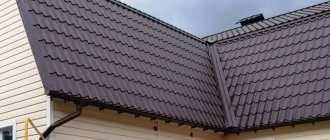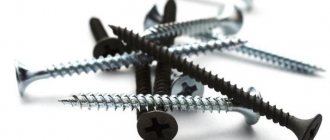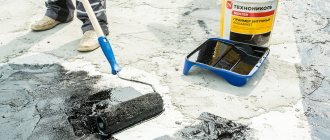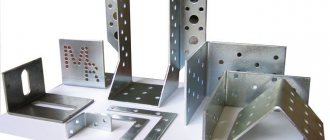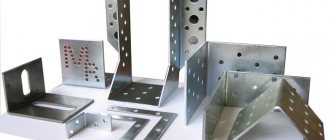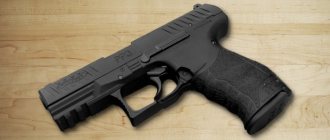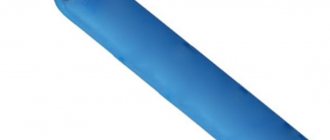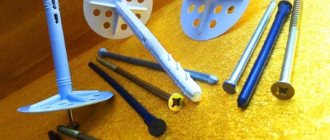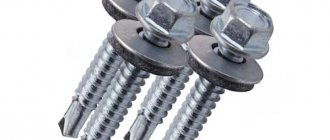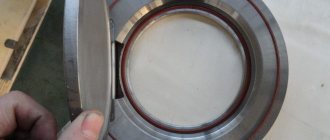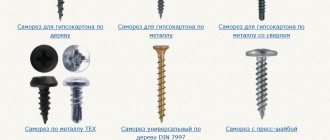Many builders who install metal tiles do not pay special attention to the accompanying elements of the roof covering, being mistaken and thinking that good quality roofing material is sufficient to achieve good results. Self-tapping screws for fastening metal tiles are just such related materials. How to fasten metal tiles using self-tapping screws, calculate the consumption of self-tapping screws for metal tiles and choose the right screws.
Roofing screws are an integral part of a strong, high-quality and durable roof.
When selecting self-tapping screws for roofing, you need to rely on quality products.
Self-tapping screws, in comparison with the roofing material, are subject to significantly greater loads not only during installation, but also during operation. Therefore, such seemingly insignificant details require a serious and balanced approach.
What types of self-tapping screws are there for roofing?
Roofing screws differ from ordinary ones in that they have a special sealing washer.
Depending on the load they will be subjected to, the following categories can be distinguished:
- Metal-metal.
- Wood-metal.
It is very important to strictly follow this classification and not use screws for other purposes.
Quite a lot of people believe that roofing screw washers will negatively affect the aesthetic appearance of the roofing. In fact, due to the fact that there are a huge number of colors of self-tapping screws on the market, you will definitely find those that will not stand out against the background, for example, metal tiles. So the screws will ensure a tight seal and will look perfect on the surface.
To obtain maximum tightness, the screws must be of sufficient quality. It is important to pay attention to the special markings that are present on the fastener head. As a rule, high-quality self-tapping screws are made of high-carbon or stainless steel. In addition, they must have an anti-corrosion coating.
It is worth noting that when using high-quality self-tapping screws, rust streaks will not appear at the fastening points of the metal tiles due to the onset of corrosion of the fasteners. The sealing rubber lining also plays an important role. Conscientious well-known manufacturers make washers for self-tapping screws from special EPMD rubber. They are characterized by better resistance to temperature changes, and they also have improved elasticity.
A little about metal tiles and self-tapping screws
This roofing material is extremely popular in Russia today. This is primarily due to its durability, low price and ease of installation. It competes only with flexible slate and its traditional asbestos-cement analogue.
The metal tiles are attached to the wooden sheathing with special self-tapping screws. They are noticeably different from other mounts in appearance. So:
- instead of the usual sharp tip, they have a drill that allows you to easily penetrate the metal of the roofing material;
- the cap has a hexagonal shape;
- It is also equipped with a rubber seal, which ensures a tight fit and tightness.
In order not to spend extra money on fasteners, you need to understand exactly in what order and quantity they are screwed into a profiled steel sheet. In addition, this allows you to avoid mistakes, in particular unnecessary holes, which are extremely difficult to repair.
Quality of self-tapping screws and calculation of quantity - how much is needed
When purchasing self-tapping screws, it is advisable to check their quality, as this may affect the total consumption of self-tapping screws for metal tiles. The screw washers must fit tightly to the metal surface. Do not use fasteners in which the rubber washer can be easily separated from the screw. Over time, such an elastic band may collapse, resulting in water seeping into the fastening points and rusty stains appearing.
It is important to know how many screws are needed per sheet of metal tile, and you should also be able to distinguish low-quality fasteners from high-quality ones. To do this, squeeze the washer with pliers. On a bad screw, the protective layer will begin to crumble or come off. Manufacturers with a reputation will not allow this, since each of their fasteners undergoes all kinds of load tests.
Steel screws must meet the following requirements:
- When the self-tapping screw is repeatedly bent by 5 degrees in opposite directions, it must withstand 20,000 vibrations.
- When the inclination increases to 10 degrees, the self-tapping screw must pass the 2000 bend test.
- With a bend of 15 degrees, the number of bends should reach 100.
High-quality products will easily pass all tests while maintaining their structure.
Currently, an increasing number of trusted metal tile manufacturers are testing their products with suitable self-tapping screws. And only when using original self-tapping screws will you receive the offered warranty from the manufacturer. This way, you will know exactly how many screws you will need per sheet of metal tile. If you do everything as the manufacturer advises, then in the end the metal roofing covering will be able to last at least up to 50 years.
Tools and materials for installation
When carrying out roofing work, it should be taken into account that they will be carried out at a fairly significant height and what seemed like a simple technological action on the ground will be very difficult to perform at a level of 5-10 meters.
Tools for installing metal tiles.
All tools used must be kept in a place where they will not fall and used only when necessary. If a hammer or screwdriver falls to the ground, you will have to go down to get it, wasting valuable time.
To work you will need a standard set of tools:
- tape measure for measuring the distance between screws;
- marker;
- hammer;
- electric screwdriver or drill with slow speed function;
- a tool for cutting metal sheets - a metal saw, an electric jigsaw or a carbide circular saw.
Consumption of self-tapping screws
Before calculating the metal tiles for the roof, many are interested in how many screws are needed for the metal tiles in order to obtain the most reliable fastening. The overwhelming number of experts claim that up to 8-10 pieces of roofing screws should be screwed in per 1 m2 of roofing material. This amount applies to regular sheets. Where there are complex curves of the roof, as well as based on the thickness of the metal and the width of the roof purlins, the calculation of self-tapping screws for metal tiles will be different.
It is worth noting that the roof covering must be attached to the wooden sheathing using 4.8×35 wood-to-metal screws.
Fastening production
It is necessary to fasten each sheet of tile with self-tapping screws to the sheathing in its lower part, in places where there is a tight junction. For this task, it is best to use metal roofing screws. They should be fixed below the step, which is a guideline in our work, by a couple of centimeters.
When screwing in the screws, the rubber gasket should deform and tightly close the space between the roof and the washer. Thanks to the vulcanizing properties of the gasket, you should get a tight connection. For such work, the most suitable self-tapping screws will be self-tapping screws with a length of at least 28 mm.
To carry out the work correctly, you will need an electric screwdriver.
Tips for securing metal tile sheets
All lower edges of the metal tile sheet are fixed with self-tapping screws into the base of the wave. Next, the screws need to be screwed in in increments of two waves, and it is better to place the fastening places of the screws in the rows in a checkerboard pattern.
It is worth considering that after laying the side sheet of metal tile overlapping, screw the screws into the ridge from each wave. Secure the end strip with self-tapping screws at intervals of 50-60 cm. Fix the ridge strip with special self-tapping screws for ridges through each wave of the metal tile.
You can determine the number of screws for metal tiles after creating a roofing project, when all the dimensions and volume of the roofing covering are available, and all complex elements of the frame structure are taken into account.
Remember that by purchasing high-quality fasteners, you will receive a reliable, powerful roof that can serve you for decades.
Scheme of fastening metal tiles with self-tapping screws
Fastening metal tiles with self-tapping screws according to the scheme guarantees a strong and reliable roof. On the edges of the slopes in the outer rows, the number of fastenings increases.
Important! If sheets have to be cut, then you need to use special disc shears. When cutting with a grinder, the protective polymer coating melts and loses its properties.
Manufacturers provide the mounting procedure on their web pages and describe them in the instructions. The number of attachment points and their spacing at the edge of the slope and in its middle are determined there.
Dimensions of self-tapping screws for metal tiles
Installation of metal tile roofing is not limited to just fixing the sheet on the roof sheathing. In addition to the main part of the work, there are two more important stages, such as sewing sheets of metal tiles together and installing additional parts - cornice and ridge strips, wind and gable corners, chimney pipes and valley assembly.
Therefore, the length of self-tapping screws for fastening metal tiles is also required for different purposes. At a minimum, three size categories are used:
- Self-tapping screws 28 mm, diameter 4.8 mm. This group can be used to fasten the thinnest and flattest types of metal tiles, but more often they are used for stitching sheets along the overlap line;
- Fasteners with a rod length of 35 mm. The most common version of the self-tapping screw is used for ordinary fixation of the sheet to the roof sheathing;
- Fastening material with a working part length of 50 mm. In certain types of roofing, additional elements require longer options with a rod of 70 mm.
Sometimes the question arises: why use fasteners with a length of 28 mm in order to connect two sheets, the thickness of which, taking into account the polymer coating, barely reaches 1 mm. The problem is in the design of the self-tapping screw and the installation technology.
Important! When laying metal tiles, the overlapped edges should not fit tightly to each other, so there is always a small compensation gap of a few millimeters between them.
When the rod is screwed in, the sharp edges cut thread grooves in the top and bottom sheets. It turns out something similar to two nuts screwed onto one bolt. It is in this position that a strong and at the same time flexible connection of the two sheets is ensured. The parts of the extensions are connected in a similar way. Naturally, correct and reliable fixation can only be achieved with high-quality fastening material.
What do you need to know about self-tapping screws?
For metal tiles, special roofing self-tapping screws with sharp tips are used. When screwed in, they cut through the covering sheet and secure it tightly.
- They are made from high-carbon galvanized steel. They do not rust for a long time from frequent contact with rainwater and snow. High-quality roofing screws are marked on the head.
- Self-tapping screws are available in different colors. This allows you to match them to the shade of the roof; they do not stand out against the background of the coating. For copper tiles, special products made from the same metal are chosen.
- The set of roofing fasteners includes rubber or latex caps and press washers. When screwed in, they are flattened, which creates an effective waterproofing in the holes. The penetration of water inside is significantly reduced. Poor quality gaskets (press washers) deteriorate over time and moisture begins to enter the holes.
- The length is at least 2.8 cm and must be 2 cm more than the total thickness of the roofing covering and the layer of waterproofing material.
Scheme and methods of fastening
Self-tapping screws are installed in the hardest place of the wave - the bottom, almost at the base of the next one. If the frame is mounted correctly, then the fasteners fall on the cross boards. You cannot place it in the upper part of the wave - in this case, the metal tiles bend.
Before starting installation, it is recommended to draw a drawing of the sheathing and roof with the screw locations marked. Too much screw consumption requires the same number of holes. This leads to more moisture getting under the roof during rain, which means the material will deteriorate faster. If you rarely install them, the tiles will vibrate from the wind, create noise and will soon become unusable.
- The outermost sheets (ends and overhang) are fixed on each wave. The same consumption is planned in the area of the ridge, valley, and valleys.
- The main part is attached through one wave.
- The metal tiles are connected to each other along the frame in increments of 1 m.
- On additional elements - 3-5 pieces per linear. m.
- The self-tapping screw should be in the center of the sheathing board or no closer than 1-1.2 cm from its edge.
To draw up a drawing and calculate the required quantity, find out how many screws are needed per square meter. Usually this is at least 8-12 screws. For a roof of complex geometric shape, the quantity is increased.
The nuances of installing metal tiles
The tiles are made from the following materials:
- cold-rolled galvanized steel sheets;
- aluminum;
- copper.
The first two have a special protective polymer coating on the surface on one or both sides that prevents exposure to ultraviolet radiation and precipitation.
According to the instructions, devices and devices that cause heating should not be used for cutting and fastening metal tiles. This is associated with the risk of damage to the protective polymer coating. It is correct to turn on the drill and screwdriver at low speeds. When screwing, it is necessary to control the pressure force; it should be moderate. Bending and too much pressure also lead to the destruction of the protective polymer layer and deformation of the material. Insufficient pressure will not fix the product securely.
Installation tools
To properly fasten metal tiles with self-tapping screws, you will need the following tools:
- roulette;
- marker;
- hammer;
- a screwdriver or drill with a low-speed function, it is acceptable to use a screwdriver; power tools are more convenient when powered by a battery rather than mains power;
- tools for cutting metal - jigsaw, metal saw, carbide circular saw.
Place tools in a convenient place to prevent them from falling from the roof.
Fastening roofing screws
When installing metal tiles, follow the following rules:
Features of installing hidden fastenings
Metal tiles with hidden fastening have some installation features that must be taken into account. The fastening elements of such metal tiles are a self-tapping screw and a press washer. Since the system is designed in such a way that the fastening point is not visible from the surface (it is covered by the next sheet), screws made of galvanized steel can be used. It is not necessary to use fasteners whose caps are painted the same color as the metal tiles. The sheets are fastened to each other by engaging all the mounting protrusions and grooves located on the edges of the sheets. The place where the sheet is fastened with self-tapping screws is hidden during installation of the next sheet. Thus, there are no fastenings or through holes on the surface. This fastening makes it possible to create an ideal roof covering, characterized by absolute tightness. The service life of a metal tile roof with hidden fastening is very long.
How to calculate soffits for a roof?
Soffits are used to cover eaves and gable overhangs. The calculator will allow you to calculate the required amount online. Soffits are calculated automatically, taking into account the material (metal or PVC), prohibited lengths and overlaps of sheets.
If necessary, you can use the calculation of the required number of screws, insulation, additional elements and components. After completing the payment, add your order to your cart and proceed to checkout. We will deliver roofing material to any region of the Russian Federation.
Features of metal tile coatings
A lot of roofing materials have appeared on sale, different brands and types. Developers choose coverage:
- by price;
- quality;
- strength;
- ease of installation.
Metal tiles made using metal technology are popular for arranging roofs:
- thin sheet steel, aluminum or copper;
- coated with polymer;
- profiled by cold pressure.
The finished plates are secured with a threaded steel screw. Self-tapping screws are produced with a special structure, similar to a drill, which pierces the metal base. They have a flat washer next to the head that secures the material tightly to the rafters. When roofing work is carried out, the placement and consumption of fasteners is determined. And roofers calculate how many screws per 1 m2 of metal roofing tiles will be needed. To avoid leaks, try not to damage metal surfaces with unnecessary holes. Screws perform 2 functions:
- pierce metal;
- are held firmly in the wood.
But the fasteners are made of an alloy, which, no matter how durable, is subject to corrosion. To prevent rust from destroying the screw, it is coated with a protective zinc agent. Due to the variety of colors of the tiles, the manufacturer began to produce hardware in different color tones, which is why they do not stand out from the general background. To enhance the tightness of the joints, self-tapping screws are made with polymer gaskets, which are placed on the rod near the head.
You need to choose a product from a reliable manufacturer if the gasket breaks and water gets into the gap, the metal begins to rust, and the wood begins to rot. One small screw can cause damage to the entire roof. Companies that produce metal tiles often complete their products with special self-tapping screws. If such a service is not provided, the developer himself selects the size. For wooden sheathing, 4.8 x 35 mm is suitable. When fastening metal sheets of complex configuration, hardware 4.8 x 20 mm is used.
Screws for metal tiles
It is a fairly common opinion that when planning the installation of a roof made of metal tiles or corrugated sheets, special attention should be paid only to the coating itself, and as for the components, you can purchase any. However, such an attitude towards fixing elements can lead to the fact that the roof will lose its reliability and aesthetics in the very near future. After all, it is the fasteners that are responsible for the strength of the decorative coating and its durability. At the same time, it is recommended to choose only special hardware designed specifically for flooring based on metal sheets, which includes metal tiles. Screws for metal tiles are called roofing screws, since they are made for a specific purpose - to fasten sheets of metal tiles to the roofing pie. Such products differ in quality, shape, size, and are not always supplied complete with roof decking. Therefore, when buying products, it is worth knowing which options are best suited for solving certain problems, as well as how to calculate the required number of screws for a specific roof.
Choosing high-quality self-tapping screws
The design of self-tapping screws created specifically for metal tiles allows them not only to easily overcome the resistance of steel, but also to be securely held in wooden structures. To prevent fasteners from rusting, a special anti-corrosion layer is applied to them at the plant. Most often, galvanic galvanizing is used - this method creates an almost indestructible bond between the top layer and the base.
All self-tapping screws are now produced in various colors that match the main palette supplied to the metal tile market. For this reason, their caps are almost invisible on the finished roof.
Most companies that manufacture the previously mentioned coating also produce self-tapping screws for it. These are the ones you should choose when purchasing everything you need for the roof. The thing is that only when using “original” products do companies provide a guarantee for the roof. Third-party consumables are grounds for refusal to fulfill obligations.
As previously noted, the tightness of the fastening is largely ensured by a rubber seal installed under the cap. Today, self-tapping screws are often supplied with polymer gaskets. By and large, the durability of the roof as a whole directly depends on the quality of this part. Cheap options are usually destroyed quite quickly by heat and dampness - as a result, water gets under the metal tiles and leaks appear. Moreover, excess moisture, falling on the unprotected end of the roofing material, leads to the formation of rust, which in just a few years can “eat out” a rather large hole in a seemingly new roof.
